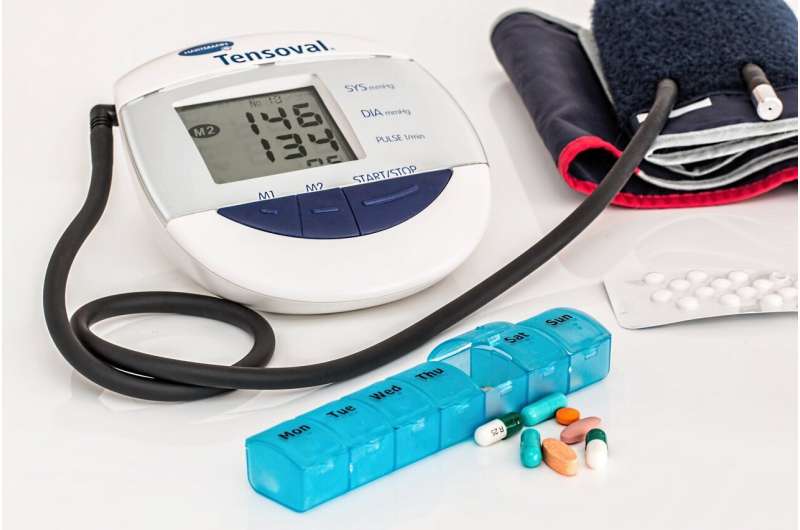This article has been reviewed according to Science X's editorial process and policies. Editors have highlighted the following attributes while ensuring the content's credibility:
fact-checked
trusted source
proofread
Study shows one injection of novel drug cuts systolic blood pressure by up to 12 mmHg

A single subcutaneous injection of the investigational drug zilebesiran, when added to existing treatment with a standard antihypertensive medication, reduced systolic blood pressure by between 4 to 12 mmHg on average at three months in patients whose blood pressure had remained uncontrolled despite compliance with their medication regimen, according to a study presented April 7 at the American College of Cardiology's Annual Scientific Session.
"Compared to placebo, a single injection of zilebesiran resulted in clinically meaningful reductions in blood pressure at three months when added to commonly used antihypertensive treatments," said Akshay Desai, MD, MPH, a cardiologist at Brigham and Women's Hospital in Boston and a study co-author. "In most cases, these differences persisted at six-month follow up despite the addition of other antihypertensive treatments. No new serious safety concerns were observed."
High blood pressure, or hypertension, is a leading cause of heart attacks, strokes and death. It occurs when the heart has to work harder to push blood through the blood vessels, increasing pressure inside the vessels. The U.S. Centers for Disease Control and Prevention (CDC) estimates that nearly half of U.S. adults—about 120 million people—have high blood pressure, but about 50% are unaware they have it because there are no symptoms.
The most common treatment for high blood pressure is daily oral medications, but many people struggle to take it consistently. The CDC also estimates that blood pressure is well-controlled with medication in about 25% of those with the condition.
Previous studies have shown that reducing systolic blood pressure (the top number in a blood pressure reading that measures the pressure in your arteries when the heart beats) by 10 mmHg results in a 20% reduction in the risk of a heart attack or stroke, Desai said.
"A safe and effective blood pressure treatment that could be dosed as infrequently as twice a year might improve consistency in blood pressure control, reduce the overall burden of pills needed to treat high blood pressure and significantly reduce patients' cardiovascular risk," he said.
Zilebesiran works by reducing the body's production of angiotensinogen, a hormone primarily made in the liver that helps to regulate blood pressure by constricting blood vessels. Reducing blood-vessel constriction allows blood pressure to fall. Unlike blood-pressure medications that need to be taken one or more times every day, zilebesiran is given by injection once every three or six months.
In a randomized study published in March 2024, patients with elevated blood pressure who were treated with zilebesiran alone saw their systolic blood pressure fall by up to 14.5 mmHg on average at six months, compared with patients who received a placebo.
The KARDIA-2 study tested whether adding zilebesiran to a standard antihypertensive medication would further reduce blood pressure in patients with hypertension who were not achieving adequate blood-pressure control on their existing medication. The global study enrolled 672 patients whose average age was 59 years; 43% were women and 28% were Black. Approximately 1 in 4 patients had diabetes other than Type 1 in addition to high blood pressure. Patients' average systolic blood pressure before receiving zilebesiran or placebo was 143 mmHg.
At study entry, most patients were taking either one or two antihypertensive medications. After discontinuing these medications, patients were randomly assigned to take one of three once-daily medications (indapamide, amlodipine or olmesartan) that are commonly used in clinical practice, representing different pharmacologic mechanisms for reducing blood pressure.
After at least 4 weeks, all patients underwent blood pressure monitoring for 24 hours. Those who consistently took their medications and still had average 24-hour systolic blood pressure between 130 mmHg and 160 mmHg were randomly assigned to receive a single injection of either zilebesiran 600 mg or placebo. Patients were then followed for an additional six months. The addition of other antihypertensive drugs was permitted at three months to achieve guideline-recommended blood pressure targets.
The study's primary endpoint was the change in average 24-hour ambulatory systolic blood pressure at three months. Secondary endpoints included the change in systolic blood pressure measured in the clinician's office at three months and the time-adjusted change in both ambulatory and office-measured systolic blood pressure at six months of follow-up.
At three months, each group of patients assigned to zilebesiran saw statistically significant additional reductions in their 24-hour ambulatory systolic blood pressure compared to placebo. For those taking indapamide, the average incremental reduction was 12 mmHg; for amlodipine, 9.7 mmHg; and for olmesartan, 4 mmHg.
Despite allowance for add-on therapy to meet guideline-recommended blood pressure targets in patients after three months, time-adjusted reductions in office systolic blood pressure between zilebesiran and placebo remained statistically significant through month six for each group.
"The fact that zilebesiran treatment resulted in significant reductions in blood pressure on top of each background treatment at three months—which persisted to six months in many cases even with treatment with additional medications—suggests that it may be a very potent new strategy for lowering blood pressure while reducing the need for daily pills."
"Importantly, in the KARDIA-2 study, the addition of zilebesiran to indapamide, amlodipine and olmesartan was associated with no new serious safety concerns with regard to potassium elevations, kidney injury and low blood pressure," Desai said.
However, he said that further studies of longer duration in patients at high cardiovascular risk are needed. A follow-up study, KARDIA-3, will test the efficacy and safety of zilebesiran in patients with hypertension uncontrolled on two to four blood pressure medications who have high cardiovascular risk or advanced chronic kidney disease.
"More studies are certainly needed, but if we can truly demonstrate safe and consistent reduction in blood pressure with two injections a year, this approach might dramatically alter the approach to managing hypertension in clinical practice," he said.



















